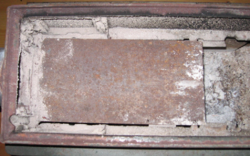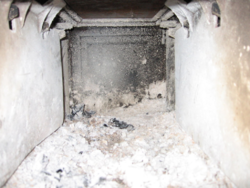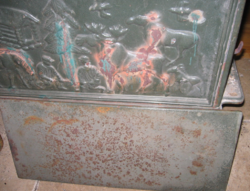Hi All,
Long time wood burner new to the forums and already learning a lot of new stuff.
Just before winter I bought a weekend getaway in Vermont. It's a small, one-bedroom A-frame with effectively no insulation. It came with an old Jotul 118 which apparently was much abused in a former life. It's got a couple small cracks in the side, a good portion of the enamel has been baked off, and it's missing the interior baffle.
Despite all that, it actually burns quite well and provides adequate if not outstanding heat, though given it's condition I'm not pushing it for maximum heat output.
Before next winter, the plan is to replace the roof with a metal roof and add some insulation in the process. I'd also like to replace the wood stove, but I'm not really sure what to replace it with. One option is to fix up the 118 and use it for a couple more winters to get an idea for how well it heats once the insulation is improved, and then use that as a point of reference when shopping for a new stove.
Which begs the question, what new stoves are comparable to an old 118? Or is it possible to make an old 118 "like new" (functionally speaking) and just keep using that?
It's also worth mentioning that there is virtually unlimited firewood available on the property. In fact, there's enough overcrowding and die-off that for me the stove is a dead wood disposal unit first, and a source of heat second, so absolute efficiency isn't my first concern.
Long time wood burner new to the forums and already learning a lot of new stuff.
Just before winter I bought a weekend getaway in Vermont. It's a small, one-bedroom A-frame with effectively no insulation. It came with an old Jotul 118 which apparently was much abused in a former life. It's got a couple small cracks in the side, a good portion of the enamel has been baked off, and it's missing the interior baffle.
Despite all that, it actually burns quite well and provides adequate if not outstanding heat, though given it's condition I'm not pushing it for maximum heat output.
Before next winter, the plan is to replace the roof with a metal roof and add some insulation in the process. I'd also like to replace the wood stove, but I'm not really sure what to replace it with. One option is to fix up the 118 and use it for a couple more winters to get an idea for how well it heats once the insulation is improved, and then use that as a point of reference when shopping for a new stove.
Which begs the question, what new stoves are comparable to an old 118? Or is it possible to make an old 118 "like new" (functionally speaking) and just keep using that?
It's also worth mentioning that there is virtually unlimited firewood available on the property. In fact, there's enough overcrowding and die-off that for me the stove is a dead wood disposal unit first, and a source of heat second, so absolute efficiency isn't my first concern.





